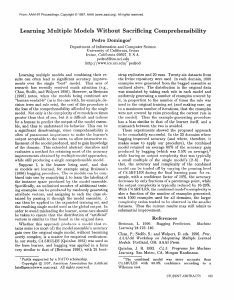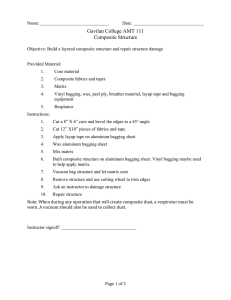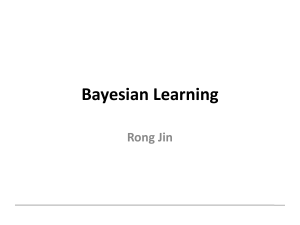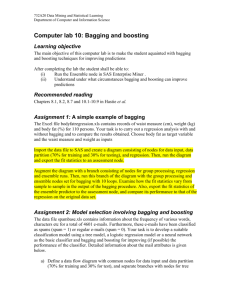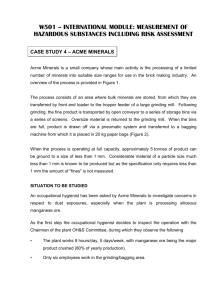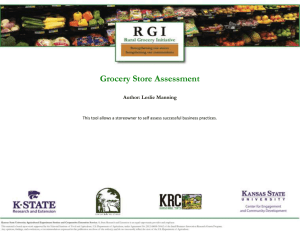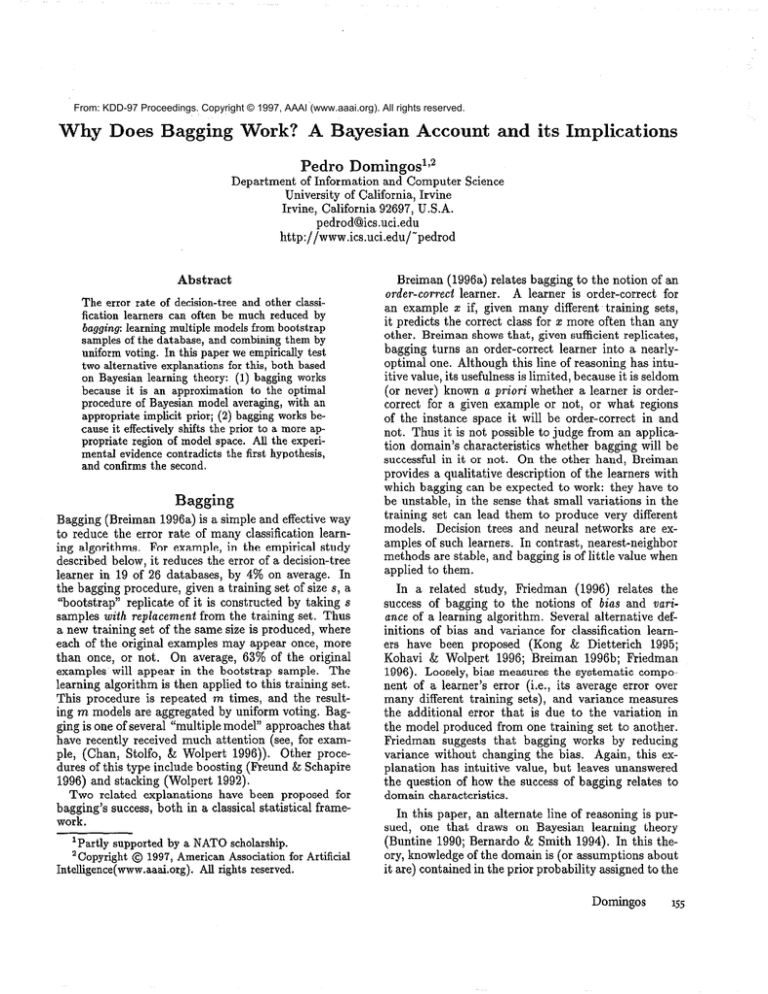
From: KDD-97 Proceedings. Copyright © 1997, AAAI (www.aaai.org). All rights reserved.
Why
Does Bagging
Work ? A Bayesian
Pedro
Account
and its Implications
Domingos1T2
Department of Information and Computer Science
University of California, Irvine
Irvine, California 92697, U.S.A.
pedrod@ics.uci.edu
http://www.ics.uci.edu/“pedrod
Abstract
The error rate of decision-tree and other cIassification learners can often be much reduced by
bagging: learning multiple models from bootstrap
samples of the database, and combining them by
uniform voting. In this paper we empirically test
two alternative explanations for this, both based
on Bayesian learning theory: (1) bagging works
because it is an approximation to the optimal
procedure of Bayesian model averaging, with an
appropriate implicit prior; (2) bagging works be-^-.,.- Ib
:c ~JrczLb~“cly
AL-a:..-I.. DILUCD
,LXL. CL,
..A,” C^
W^.._ apmm
La.UwG
bllC FLI”L
b” an ILI”IG
propriate region of model space. All the experimental evidence contradicts the first hypothesis,
and confirms the second.
Bagging
R"mn:nm
Ucb~~llltj
rRrAm.3"
\UI~IIII~Ll
1aaf?a\
J..aU"cb,
;n co
0 &mnl,a
AU
ullllyl.a
nnrl
UlllU c.fF,wt;.m
bILbU"I "b Tllll,
."cuJ
to reduce the error rate of many classification learning algorithms.
For example, in the empirical study
described below, it reduces the error of a decision-tree
learner in 19 of 26 databases, by 4% on average. In
the bagging procedure, given a training set of size s, a
“bootstrap” replicate of it is constructed by taking s
samples with replacement from the training set. Thus
a new training set of the same size is produced, where
---L “L
-c LL--:-:--I
^__^- -,-- -__.
^__^^_ “lltx,
^_^^ III”Lt:
-^-^
eacll
IAle “rlg’
l’al anarrlpK3
Illay cbppca~
than once, or not. On average, 63% of the original
examples will appear in the bootstrap sample. The
learning algorithm is then applied to this training set.
This procedure is repeated m times, and the resulting m models are aggregated by uniform voting. Bagging is one of several “multiple model” approaches that
have recently received much attention (see, for example, (Chan, Stolfo, & Wolpert 1996)). Other procedures of this type include boosting (Freund & Schapire
1996) and stacking (Wolpert 1992).
Two related explanations have been proposed for
bagging’s success, both in a classical statistical framework.
‘Partly supported by a NATO scholarship.
-Jr,v...,:,l.+ A
n-,,:,,,
A,,,,:,*:,,
F,,
*,*:c,:,,
““pJupb
rq, II-m?
IJJ I, rkILI1;IIball
.cxYO”Lub”I”U
I”I xlI”IIILIo*L
Intelligence(www.aaai.org). All rights reserved.
Breiman (1996a) relates bagging to the notion of an
order-correct learner. A learner is order-correct for
an exampie z if, given many different training sets,
it predicts the correct class for z more often than any
other. Breiman shows that, given sufficient replicates,
bagging turns an order-correct learner into a nearlyoptimal one. Although this line of reasoning has intuitive value, its usefulness is limited, because it is seldom
(or never) known a priori whether a learner is ordercorrect for a given example or not, or what regions
of the instance space it will be order-correct in and
not. Thus it is not possible to judge from an appiication domain’s characteristics whether bagging will be
successful in it or not. On the other hand, Breiman
provides a qualitative description of the learners with
which bagging can be expected to work: they have to
be unstable, in the sense that small variations in the
training set can lead them to produce very different
models. Decision trees and neural networks are examples of such learners, In contrast, nearest-neighbor
methods are stable, and bagging is of little value when
applied to them.
In a related study, Friedman (1996) relates the
success of bagging to the notions of bias and variance of a learning algorithm. Several alternative definitions of bias and variance for classification learners have been proposed (Kong & Dietterich i995;
Kohavi & Wolpert 1996; Breiman 1996b; Friedman
1996). Loosely, bias measures the systematic component of a learner’s error (i.e., its average error over
many different training sets), and variance measures
the additional error that is due to the variation in
the model produced from one training set to another.
Friedman suggests that bagging works by reducing
variance without changing the bias. Again, this explanation has intuitive value, but leaves unanswered
the question of how the success of bagging relates to
domain characteristics.
In this paper, an alternate line of reasoning is pursued, one that draws on Bayesian learning theory
(Buntine 1990; Bernard0 & Smith 1994). In this the~PV
VLJ,
Irnnwl~clw
ALAAV,. ““b.2
nf
VL t.ho
YIAV rlnm~in
UYIII..,~II
ia
A” Inr
\“A
a.xnmn+inn~
LwA.u&‘.Ly”IvI~Y
it are) contained in the prior probability
ahnut
~V”U”
assigned to the
Domingos
155
different models in the model space under considera-
(i.e., each example’s class is corrupted with probability
tinn
“IVL’)
F), Pfdrr:
\-“,
t.ho
“AA” trnininrr
“‘“““~‘b
wt. *”
ia t.alwn
int,n -“”
acrnnnt
y.Ly
. -&.-- * &&&“.,
-IAA _ hv
‘-J
rnmnut,./...--p‘-”
ing the likelihood of each model given the data, and
optimal classification is performed by voting among
the models, with each model’s weight being its posterior probability (the product of the prior probability
and the likelihood).
Simply choosing the single best
model, as most learners do, is only an approximation
to the optimai procedure. Since bagging eiFectiveiy
samples the model space, and then performs classification by voting among the models found, the question
naturally arises: can bagging’s success be due to its
being a closer approximation to the optimal Bayesian
procedure than simply choosing the best model? And
if so, what prior assumptions does its uniform voting
procedure imply ? Alternatively, bagging can be regarded as forming a single new model composed of the
m bagged models, and choosing it. In this case, bagging in effect changes the model space, or at least redistributes probability from the component models to
the composite ones. These two interpretations (bagging approximates Bayesian model averaging vs. bagging changes the priors) have very different implications, In the first, the underlying. learner is assumed
to fit the domain well, and error is reduced by refining the inference procedure (averaging models, instead
of selecting one). In the second, inference according
to a single model is an acceptable approximation, but
the underlying learner is making incorrect assumptions
about the domain, and error is reduced by changing it.
This paper tests these two hypotheses empirically,
and discusses the implications of the results. After a
hG.4
lJI,CL
nn.r;zmr
IG”,rjYY
“IA
Rn.rodnn
thmv.v
LKbJ.xuc&un
urrb”rJ)
tho
“ILb fir&
ill””
hww,thm;.
“Jy”“I’“uI”
;a
IU
tested, followed by the second one.
Bayesian
Learning
Theory
Modern Bayesian approaches to learning differ from
classical statistical ones in two main respects (Buntine 1990):
-I- the
---- computation of posterior probabilities
from prior probabilities and likelihoods, and their use
in model averaging. In Bayesian theory, each candidate model in the model space is explicitly assigned
a prior probability, reflecting our subjective degree of
belief that it is the %orrect” model, prior to seeing the
data. Let n be the training set size, 2 the examples
in the training set, c’the corresponding class labels,
and h a model (or hypothesis) in the model space H.
Then
-~-“--)
hv
~J Rnvw’
IIJ-I n
I thnnrem.
-!---------,
anrl
a.ccqllminp
____ -CL____-o
the.
>--- examples
r:lh.\
If .h
I%,.“, = 1 - F_ :_
nrdlrta *
p--x.-J.A
thp
2a-v rnrrect
--*-“--!
rlnnn
-_-I-
~2
“.~
for pi, and Pr(~i, ci Ih) = E if h predicts an incorrect
class. Equation 1 then becomes:
Pr(hlZ, ~3)CCl+(h) (1 - E)%‘+~
(2)
where s is the number of examples correctly classified
by h. An alternative approach (Buntine 1990) relies
on the fact that, implicitly or explicitly, a classification
model divides the instance space into regions, and labels each region with a class. For example, if the model
is a decision tree (Quinlan 1993), each leaf corresponds
to a region. A noise level can then be estimated separately for each region, by making:
Pr(xi,
cJh) = 7
where r is the region xi is in, n, is the total number
of training examples in r, and nT,ci is the number of
examples of class ci in r.
Finally, a test example 2 is assigned to the class that
maximizes:
Pr(clx,
I, Z, N) = x
Pr(clx,
h) Pr(hli!,
E)
(4)
hEH
If a “pure” classification model is used, Pr(clx, h) is
1 for the class predicted by h for x, and 0 for all others. Alternatively, a model supplying class probabilities such as those in Equation 3 can be used. Since
there is typically no closed form for Equation 4, and
the model space used typically contains far too many
modeis to aiiow the fuii summation to be carried out,
some procedure for approximating Equation 4 is necessary. Since Pr(hl 2+, c3 is often very peaked, using only
the model with highest posterior can be an acceptable
approximation. Alternatively, a sampling scheme (e.g.,
Markov chain Monte Carlo (Madigan et al. 1996)) can
be used.
Empirical
Tests of the First
Hypothesis
This section empirically tests the following hypothesis:
1. Bagging
reduces a classification
learner’s
error
rate
because it more closely approximates Equation 4 than
the single model output by the learner.
Obviously, this hypothesis assumes the learner indeed
ontni1t.s
---I-----
8 single
meodeij
and_
is Only
releva.nt
_ -_- -__.
for
where f+(h) is the prior probability of h, and the product of Pr(si, cilh) terms is the likelihood. The data
those (learner, domain) pairs where bagging does in
fact reduce error. If this hypothesis is correct, given m
bootstrap replicates of the training set, bagging samples m high-posterior terms from Equation 4. This is
plausible, since a sensible learner will produce a highposterior model given its training set. More problematic is the fact that bagging assigns uniform weight to
all models sampled, i.e., it assumes they all have the
nr;nx
prrvr
ss~*e
are drawn independently, the posterior probability
h given (2, $) is given by:
of
(1)
1lJm(S
r \.u, ;;?
v, ;a
I” tha
“LA” CP~P
VullllU
be ignored. If a uniform
156
KDD-97
fnr
IYL all
WII mnrlplc
“‘VY..~“)
nnrl
-a...
ran
Y-AA t.hnc
.,.A-”
class noise modelis assumed
post,&~r
nrohnhi1it.v.
=--“----~J) irresnwtive
-----=----.
hood. One possible interpretation
- of
t,h&
(Hypothesis
i&e&
la) is
that this is simply an imperfection in bagging’s approximation, and better results would be obtained by
correctly weighing the models by their posteriors, assuming (conservatively) an uninformed prior (e.g., uniform). Alternatively, bagging may be regarded as assuming a prior probability distribution that approximately cancels the likelihood for these models (Hypothesis lb). Both these variants of Hypothesis 1 were
tested.
A decision-tree learner, C4.5 release 8 (Quinlan
Twenty-six
1993), was used in all experiments.3
databases from the UC1 repository were used4 (Merz,
Murphy, & Aha 1997). Hypothesis la was tested
by comparing bagging’s error with that obtained by
weighing the models according to Equation 1, using
both a uniform class noise model (Equation 2) and
Equation 3. Equation 4 was used in both the “pure
classification” and “class probability” forms described.
Initially, m = 25 bootstrap replicates were used. Error
was measured by ten-fold cross-validation. In all cases,
non-uniform weighting performed worse than bagging
on a large majority of the datasets (e.g., 19 out of ZS),
and worse on average. The best-performing combination was that of uniform class noise and “pure classifif.nt;nn
l?txv th;n
the
avnox-imenlE
WPIW
TV=“Al.2 ““y~&LLL~“““”
.I”&” IY
IlbW”I”II. )’ &“I
“ill” ~na~~~~n
‘“‘UI”“)
peated with m = 10, 50, and 100, with similar results.
Since Bayesian model averaging with a uniform prior
consistently performs worse than bagging, it is unlikely
that bagging works because it is an approximation to
that procedure, and the empirical evidence thus contradicts Hypothesis la.
If Hypothesis lb is correct, exactly what prior is being assumed by bagging? Since the likelihood decreases
exponentially with training-set error (see Equation 2,
and consider that E 5 4 by definition, and the trainingset error is (n - s)/n), a p rior that cancels the likelihood must increase exponentially with training-set error, at least in the region(s) of model space occupied
by the models sampled by bootstrapping. This use of
training-set information in the prior is not strictly allowed by Bayesian theory, but is nevertheless common
(Cheeseman 1990). Although counter-intuitive, penalizing models that have lower error on the training data
simply corresponds to an assumption that the models
over@! the data, or more precisely, that the models that
have lower error on the training data will in fact haver
higher error on test data. Since learners that overfit are
also necessarily unstable learners, or learners with high
variance, and these are the learners for which Breiman
(1996a) and Friedman (1996) found bagging will work,
it is plausible that bagging incorporates a prior that is
3The C4.5RULES post-processor was used, since it
tended to reduce error.
4Audiology, annealing, breast cancer, credit, diabetes,
echocardiogram, glass, heart disease, hepatitis, horse colic,
iris, labor, lenses, LED, lung cancer, liver disease, lymphography, post-operative, promoters, primary tumor, solar flare, sonar, soybean, voting, wine, and zoology.
appropriate to those learners. Whether this assumption that bagging incorporates an error-favoring prior
is correct for the databases and learner used can be
tested by checking the sign and magnitude of the correlation between each model’s in-bag error (i.e., on the
data it was learned on) and out-of-bag error (i.e., on
the remaining data). Doing this results in the observation that, although the models are almost always overfitted in the sense that their error is lower in-bag than
out-of-bag, the correlation between in-bag and out-ofbag error is positive in all but four of the 26 databases,
and is greater than 0.5 in half the databases where it
is positive. Thus lower in-bag error is almost always
accompanied by lower out-of-bag error, and using an
error-favoring prior should increase error, not reduce it,
as bagging does. This evidence contradicts Hypothesis
lb.
Empirical
Tests of the Second
Hypothesis
This section empirically tests the following hypothesis:
2. Bagging reduces a classification learner’s error rate
because it changes the learner’s model space and/or
prior distribution to one that better fits the domain.
As before, a learner outputting a single model is assumed, and this hypothesis is only relevant in cases
where bagging indeed reduces error. Most learners
do not employ an explicit prior distribution on models. However, since they invariably have learning biases
that lead them to induce some models more often than
others, and these biases are known before the learner
is applied to any given training set, these biases can be
considered to imply a corresponding prior probability
distribution.
Specifically, most decision tree and rule
learners (including C4.5) incorporate a simplicity bias:
they give preference to simpler models, on the assumption that these models will have lower error on a test
set than more complex ones, even if they have higher
error on the training set. Simplicity can be measured
in different ways, but is typically related to the size of
the decision tree or rule set produced (e.g., the number of nodes in the tree, or number of conditions in all
the rules). Because, given m replicates, bagging produces m models, its output is (in naive terms) on the
order of m times more complex that that of the base
learner. A plausible hypothesis is then that, when it
works, bagging is in effect counteracting an inappropriate simplicity bias, by shifting probability to more
complex models.
If this instantiation of Hypothesis 2 is to be effectively tested, bagging’s output complexity must be
more carefully evaluated. Syntactically, sets of decision trees constitute a different model space from individual decision trees, even if the set of classifications
they can represent is the same, and thus it is questionable to directly compare the complexity of models
Domingos
1.57
in the two representations. A bagged set of m decision trees { DTr , DTz, . . . , DTm} can be trivially transformed into a single decision tree by placing a replica
of DT2 at each of DTl ‘s leaves, then a replica of DT3 at
each leaf of each replica of DT2, and so on up to DT,,
and then labeling each leaf node of the composite tree
with the class assigned to it by the bagged ensemble.
However, this produces a decision tree whose complexity is exponential in m, and is likely to be far more
complex than necessary to replicate the bagged ensemble’s classification decisions. Rather, we would like to
find the simplest decision tree extensionally representing the same model as a bagged ensemble, and compare its complexity with that of the single tree induced
from the whole training set. Although this is likely to
be an NP-complete problem (Hyafil & Rivest 1976),
an approximation to this approach can be obtained
by simply applying the base learner to a training set
composed of a large number of examples generated at
random, and classified according to the bagged ensemble. The decision tree produced in this way models the
bagged ensemble’s division of the instance space into
class regions. Exactly the same simplicity bias is applied to learning this tree as to learning a tree directly
from the original training set, making the complexities
of the two directly comparable.
This “meta-learning” procedure was carried out for
the 26 databases previously mentioned, using C4.5 as
before. Details and full results are given elsewhere
(Domingos 1997). In all but four of the 22 databases
where bagging improves on the single rule set, metalearning also produces a rule set with lower error, with
over 99% confidence according to sign and Wilcoxon
tests. Its error reductions are on average 60% of bagging’s, indicating that the rule set produced is only
an approximation of the bagged ensemble’s behavior. Measuring complexity as the total number of antecedents and consequents in all rules, the new rule
set is more complex than the directly-learned one in
every case, typically by a factor of 2 to 6. Moreover,
varying the pruning level during meta-learning and the
size of the meta-learning training set lead to the observation that error and complexity are inversely correlated (i.e., complexity tends to increase when error decreases). Thus the empirical evidence agrees with the
hypothesis that bagging works by effectively changing
a single-model learner to another single-model learner,
with a different implicit prior distribution over models,
one that is less biased in favor of simple models.
Conclusion
This paper tested two alternative explanations for bagging’s success. Given the empirical evidence, it is unlikely that bagging works because it is an approximation to Bayesian model averaging, and it is plausible
that it works at least in part because it corrects for an
overly-strong simplicity bias in the underlying learner.
158
KDD-97
References
Bernardo, J. M., and Smith, A. F. L. 1994. Bayesian
Theory. New York, NY: Wiley.
Breiman, L. 1996a. Bagging predictors.
Machine
Learning 24:123-140.
Breiman, L. 1996b. Bias, variance and arcing classifiers. Technical Report 460, Statistics Department,
University of California at Berkeley, Berkeley, CA.
Buntine, W. L. 1990. A Theory of Learning C’lassification Rules. Ph.D. Dissertation, School of Computing
Science, University of Technology, Sydney, Australia.
Chan, P.; Stolfo, S.; and Wolpert, D., eds. 1996. Proc.
AAAI-96 Workshop on Integrating Multiple Learned
Models. Portland, OR: AAAI Press.
Cheeseman, P. 1990. On finding the most probable
model. In Shrager, J., and Langley, P., eds., Computational Models of Scientific Discovery and Theory
Formation. San Mateo, CA: Morgan Kaufmann.
Domingos , P. 1997. Knowledge acquisition from
In Proc. Fourexamples via multiple models.
teenth International
Conference on Machine Learning. Nashville, TN: Morgan Kaufmann.
Freund, Y., and Schapire, R. E. 1996. Experiments
with a new boosting algorithm. In Proc. Thirteenth
International Conference on Machine Learning, 148156. Bari, Italy: Morgan Kaufmann.
Friedman, J. H. 1996. On bias, variance, O/l - loss,
and the curse-of-dimensionality. Technical report, Department of Statistics and Stanford Linear Accelerai
tor Center, Stanford University, Stanford, CA.
Hyafil, L., and Rivest, R. L. 1976. Constructing optimal binary decision trees is NP-complete. Infomzation Processing Letters 5:15-17.
Kohavi, R., and Wolpert, D. H. 1996. Bias plus
variance decomposition for zero-one loss functions.
In Proc. Thirteenth International Conference on Machine Learning, 275-283. Bari, Italy: Morgan Kaufmann.
Kong, E. B., and Dietterich, T. G. 1995. Errorcorrecting output coding corrects bias and variance.
In Proc. Twelfth International
Conference on Machine Learning, 313-321. Tahoe City, CA: Morgan
Kaufmann .
Madigan, D.; Raftery, A. E.; Volinsky, C. T.; and
Hoeting, J. A. 1996. Bayesian model averaging.
In Proc. AAAI-96 Workshop on Integrating Multiple
Learned Models, 77-83. Portland, OR: AAAI Press.
Merz, C. J.; Murphy, P. M.; and Aha, D. W. 1997.
UC1 repository of machine learning databases. Department of Information and Computer Science, University of California at Irvine, Irvine, CA.
Quinlan, J. R. 1993. C4.5: Programs for Machine
Learning. San Mateo, CA: Morgan Kaufmann.
Wolpert, D. 1992. Stacked generalization.
Neural
Networks 5:241-259.

